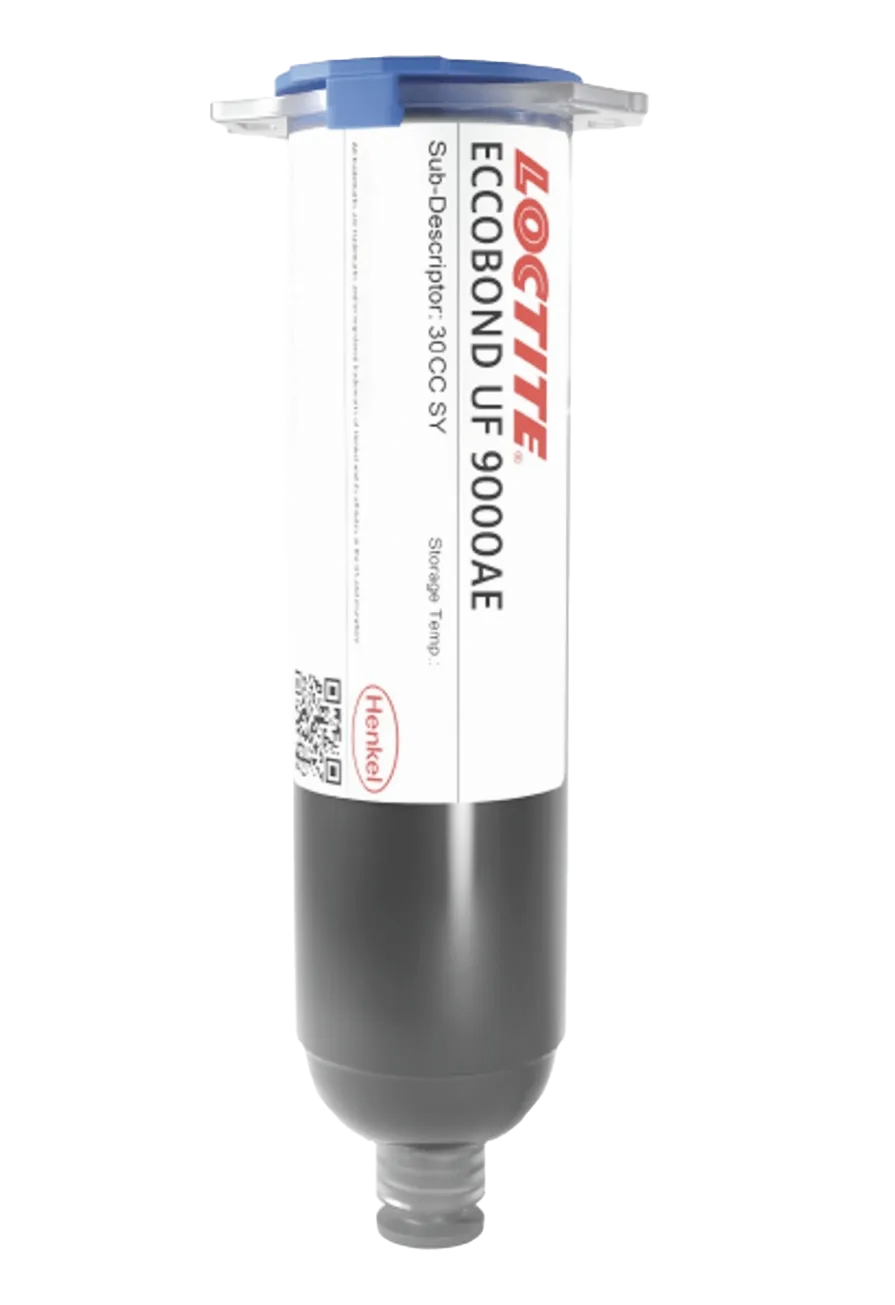LOCTITE ECCOBOND UF 9000AE
- Low die warpage
- Best large die underfill
- 260°C reflow capability for Pb- free, low-k applications
Product Description
LOCTITE® ECCOBOND UF 9000AE is a cutting-edge semiconductor capillary underfill designed specifically to meet the demands of next-generation flip-chip BGA (FCBGA) and high-density fan-out (HD-FO)/2.5D integrated advanced packaging designs. These technologies, critical for AI and high-performance computing (HPC) applications, feature large, high-density I/O die within expansive package dimensions, making warpage prevention and die protection crucial for long-term reliability.
LOCTITE® ECCOBOND UF 9000AE excels in this environment by offering robust protection against die warpage and cracking, which are common concerns due to the fine-pitch interconnects found on large die. This PFAS-free epoxy encapsulant boasts a fast flow rate, ensuring that it can fill gaps efficiently while maintaining the integrity of the delicate interconnects. Its high fracture toughness further enhances durability, ensuring that the die remains protected under various operational stresses.
Once fully cured, LOCTITE® ECCOBOND UF 9000AE forms a rigid, self-filleting protective seal that significantly improves the reliability of solder joints. This protective layer not only extends the electrical, thermal, and moisture resistance of the package but also helps to dissipate stress, thereby enhancing overall performance and longevity. The underfill’s low thermal expansion, fast capillary flow, and extended work-life make it an ideal solution for complex, high-density semiconductor packages, ensuring both comprehensive interconnect protection and high processability. It is the best underfill for large die sizes and flip chips applications with small gaps.
Cure schedule
- 15 minute ramp to 100°C; 90 minute hold @ 100°C + 15 minute ramp from 100°C to 165°C; 2 hour hold @ 165°C
Technical Specifications
| General Properties | |||||||
| Pot Life Pot Life Pot life is the amount of time it takes for the viscosity of a material to double (or quadruple for lower viscosity materials) in room temperature after a material is mixed. It is closely related to work life but it is not application dependent, less precise and more of a general indication of how fast a system is going to cure. | 24 hours | ||||||
| Specific Gravity Specific Gravity Specific gravity (SG) is the ratio of the density of a substance to the density of a reference substance; equivalently, it is the ratio of the mass of a substance to the mass of a reference substance for the same given volume. For liquids, the reference substance is almost always water (1), while for gases, it is air (1.18) at room temperature. Specific gravity is unitless. | 1.71 | ||||||
| |||||||
| Physical Properties | |||||||
| Thixotropic index Thixotropic index Thixotropic Index is a ratio of a material s viscosity at two different speeds in Ambient temperature, generally different by a factor of ten. A thixotropic material s viscosity will decrease as agitation or pressure is increased. It indicates the capability of a material to hold its shape. Mayonnaise is a great example of this. It holds its shape very well, but when a shear stress is applied, the material easily spreads. It helps in choosing a material in accordance to the application, dispense method and viscosity of a material. | 0,085 | ||||||
| Viscosity Viscosity Viscosity is a measurement of a fluid’s resistance to flow. Viscosity is commonly measured in centiPoise (cP). One cP is defined as the viscosity of water and all other viscosities are derived from this base. MPa is another common unit with a 1:1 conversion to cP. A product like honey would have a much higher viscosity -around 10,000 cPs- compared to water. As a result, honey would flow much slower out of a tipped glass than water would. The viscosity of a material can be decreased with an increase in temperature in order to better suit an application | 9,082 mPa.s | ||||||
| Mechanical Properties | |||||||
| |||||||
| Thermal Properties | |||||||
| |||||||
| Glass Transition Temperature (Tg) Glass Transition Temperature (Tg) The glass transition temperature for organic adhesives is a temperature region where the polymers change from glassy and brittle to soft and rubbery. Increasing the temperature further continues the softening process as the viscosity drops too. Temperatures between the glass transition temperature and below the decomposition point of the adhesive are the best region for bonding. The glass-transition temperature Tg of a material characterizes the range of temperatures over which this glass transition occurs. | 111 °C | ||||||
Additional Information
Key features and benefits
High Reliability
- Low shrinkage and high toughness (K1c = 3.0) offer die and underfill crack resistance
- Low CTE (23 ppm/°C below Tg), highly filled system reduces warpage propensity
- Low/no-voiding bump encapsulation for fine-pitch I/O (100 μm) and low gap heights (> 45 μm)
- Good reliability across all metrics (MSL3a + 2,000 TCT-B cycles, 192 hr. uHAST. 1,000 hr. HTS at 150°C)
Excellent Workability/Processability
- Fast flow for high UPH; 20% faster than previous-generation material*
- Low resin bleed out (RBO) and narrow fillets allow denser chip integration
- Thorough coverage on large die up to 50 mm x 50 mm, and demonstrated effectiveness with large package bodies up to 110 mm x 110 mm
- Excellent workability; long stage life at 100° C
Value Protection
- Proven performance on flip-chip BGA, Cu pillar, and other high-density interconnect designs
- Safeguards large, thin die in complex, 2.5D AI and HPC packages



